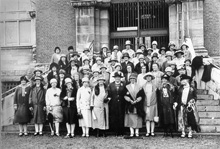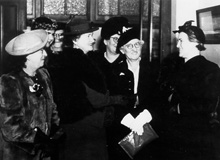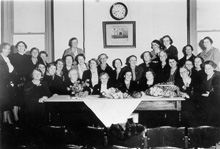
Labor Woman
Soon after arriving in the west, Elsie had joined the Perth Branch of the Labor Women's Organisation [LWO], and through this network got to know Jean Beadle – with whom she and John formed a firm friendship – and other campaigners for women's rights. 38
After the Curtins moved to Cottesloe, Elsie played an active role in the Fremantle Branch of the LWO, including holding the office of Treasurer. 39 Like many other women in the labor movement, her management of the family finances was merely extended by taking on the office of treasurer of the various ALP committees. Also like her contemporaries, Elsie's interests extended well beyond the ALP into community welfare work and cultural interests.
By 1935, she was Vice President of the Cottesloe Infant Health Welfare Centre. She also found time to join a choir in Fremantle and took part in a performance of The Messiah at Christmas 1935 (and possibly in other years), in which she sang a contralto part. 40
When the media 'discovered' Elsie in 1935 at the time of her husband's election to leadership of the ALP, she was invariably announced as a woman who 'likes home life', 41 'home loving' and 'a silent partner'. 42 Sometimes her early interest in politics in Cape Town and Hobart was mentioned, but almost never her commitment to the Western Australian Labor movement.
During the six years that Curtin was ALP Leader and Leader of the Opposition in the Federal Government, Elsie Curtin gave a number of interviews, in which she reiterated that 'home duties' kept her from being very active in public life, yet as we have seen, she was active in the labor movement and in other groups in the community.
One of the few interviews to quote Elsie's views, by a reporter from the Adelaide newspaper The Mail in October 1935, depicted Elsie as 'petite, grey-haired and brown-eyed' and described her as spending her spare time reading in 'her little lounge room surrounded by books'.
In this interview, Elsie stated that freeing people 'from the fear of poverty' and enabling them to be 'certain of at least necessities of life' would give her 'a thrill'. While 'delighted' that her husband had been elected leader of the ALP, she knew that it would mean less time at home for him.
She also expressed the opinion – which caught the imagination of the headline writer – that Australian women would value their political equality far more 'if they had been forced to fight for it'. 43 Australian women did have to fight for political equality, and although the campaign for the vote was fought while Elsie was in South Africa, it seems curious that she was unaware of it, and of the fact that when she arrived in Western Australia, women were still barred from standing for the State Parliament, a right that was legislated only in 1920. 44
Elsie saw her primary duty as maintaining a home for her two teenage children. The first time she left home, daughter Elsie was only 18 and son John, 15, although Annie Needham was living with them. This trip, in 1936, involved a tour of several weeks' duration with John to Melbourne, Hobart and Launceston as well as what Elsie described as a 'second' or 'proper' honeymoon at the Hotel Kurrajong in Canberra. 45
Even after Elsie and John had left school and entered the workforce, their mother felt this same sense of duty. When John joined the RAAF at the beginning of World War II, it was important to Elsie to maintain the home in Cottesloe as a place to which he could return on leave from his station in Geraldton.
Presumably Annie Needham, who was in her 80s by the time John Curtin became Prime Minister, was too elderly to manage the house on her own – although this was never mentioned as a reason for Elsie remaining in Perth. 46
In addition to these family commitments, the lengthy journey by train or sea between Perth and Melbourne, before a further train journey to Canberra, added weeks to any stay in the eastern states. After her husband became Prime Minister, when plane travel was a possibility, Elsie confessed to an 'aversion' to flying. 47

Delegates to the Conference of Western Australian Labor Women outside Museum & Art Gallery, Elsie Curtin 4th from left, front row, October 1927.
Records of the Curtin Family. JCPML00376/162

Elsie Curtin at Labor Congress, 1941.
Records of the Curtin Family. JCPML00376/127

Fremantle Labor Women's Group (including Elsie Curtin) at Fremantle Trades Hall, celebrating John Curtin becoming Prime Minister, 14 October 1941.
Records of the Curtin Family. JCPML00376/161
 |
|||||||||||||
 |
|||||||||||||